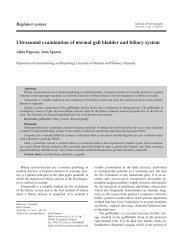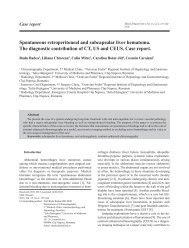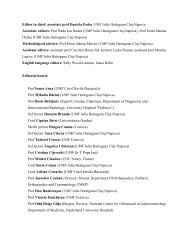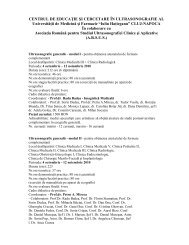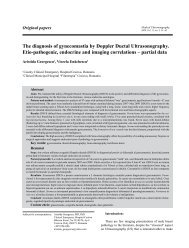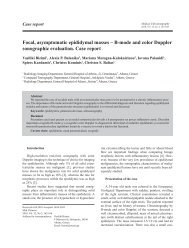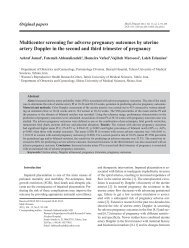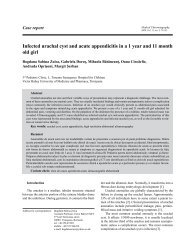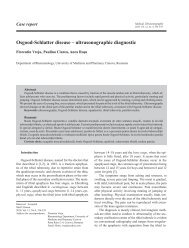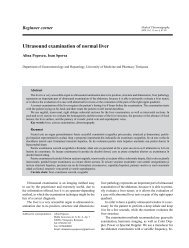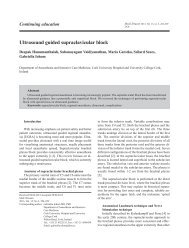Ultrasound of the median arcuate ligament syndrome - Medical ...
Ultrasound of the median arcuate ligament syndrome - Medical ...
Ultrasound of the median arcuate ligament syndrome - Medical ...
You also want an ePaper? Increase the reach of your titles
YUMPU automatically turns print PDFs into web optimized ePapers that Google loves.
such as “deformed” celiac trunk angiograms ± depiction<strong>of</strong> a externally compromising s<strong>of</strong>t tissue string (<strong>median</strong><strong>arcuate</strong> <strong>ligament</strong>). For all patients but one a correspondingCT (including CT-Angiography) was available; onepatient had undergone even magnetic resonance imaging(MRI) (including contrast enhanced MR-Angiography)and two had undergone conventional Angiography. Onlyone patient had undergone MR-Angiography (includingcontrast enhanced MR-Angiography). Of <strong>the</strong>se patientsthree had undergone surgical repair (decompression) ±percutaneous transarterial angioplasty (PTA) and threeare still under clinical observation while scheduled forintervention.A total <strong>of</strong> 20 age matched asymptomatic volunteers(mean age 37.7 years ± 8.8; mean body mass index[BMI] 22.4 kg/m² ± 2.8) underwent <strong>the</strong> same standardizedultrasound algorithm for comparison and validation<strong>of</strong> patient features.Informed consent on <strong>the</strong> utilization <strong>of</strong> anonymizeddata for study purposes was obtained from all subjectsaccording to <strong>the</strong> World <strong>Medical</strong> Association Declaration<strong>of</strong> Helsinki (59 th WMA Assembly, Seoul, 2008)[12]. Institutional review board approval was granted bymeans <strong>of</strong> a general waiver for studies with retrospectivedata analysis (Ethikkommission, Med. Univ. Innsbruck;2009-02-20). Each image, measurement and assessmentwas documented for statistical evaluation using SPSS®(PASW Statistics, Version 18.0.0, Chicago, IL, USA) inan Micros<strong>of</strong>t Excel®-file (Micros<strong>of</strong>t Corp., Redmont,Wash., USA) or in our institutional Agfa®-PACS (AgfaAG, Mortsel, BEL).Specificity, sensitivity, positive and negative predictivevalue (PPV; NPV) and prevalence were calculatedfor inspiratory PV, expiratory PV, percent <strong>of</strong> amplitudechange, <strong>the</strong> DA+ and <strong>the</strong> combination <strong>of</strong> a DA+ and <strong>the</strong>according expiratory PV. Correlation tests (Kendall-τ;Spearman-ρ) were performed to assess possible coherencesbetween volunteer data and BMI.Statistical differences <strong>of</strong> <strong>the</strong> Doppler-US data betweenpatients and volunteers were calculated by nonparametricMann-Whitney-U(MWU)-testing (significancelevel α ≤0.05 for 2-tailed and α ≤0.025 for 1-tailedtesting) and by contingency testing concerning statisticalindependence <strong>of</strong> cross-tabulated categorical data with aχ²- test based Ф-coefficient calculation (significance onstochastic independence at α=0,01; χ² 1-tailed with 1degree <strong>of</strong> freedom) based on <strong>the</strong> following empiricallydefined thresholds: inspiratory PV =150 cm/s, expiratoryPV = 350 cm/s and DA+ according to <strong>the</strong> distribution <strong>of</strong>features in <strong>the</strong> available data.Box-plots were built for illustration <strong>of</strong> inspiratoryPV-, expiratory PV-, and PV-amplitude-distribution.<strong>Medical</strong> Ultrasonography 2012; 14(1): 5-9Fig 3. Distribution <strong>of</strong> (Doppler-) US values in patients.Fig 4. Distribution <strong>of</strong> (Doppler-) US values in volunteers.ResultsThe 6 MALS-patients and 40% (8/20) <strong>of</strong> volunteerspresented a DA+. The patients presented a mean inspiratoryPV <strong>of</strong> 172 cm/s (± 40.9 cm/s), a mean expiratory PV<strong>of</strong> 425 cm/s (± 130.1 cm/s) with an amplitude <strong>of</strong> 249.1%± 68.9 (fig 3). The volunteers presented a mean inspiratoryPV <strong>of</strong> 126.9 cm/s (± 42 cm/s), a mean expiratory PV<strong>of</strong> 209.9 cm/s (± 80.1cm/s) with amplitude <strong>of</strong> 169.4% ±54.3 (fig 4).The statistical assessment defined a significant inversecorrelations <strong>of</strong> <strong>the</strong> probands BMI and <strong>the</strong> PV measured(Kendall-τ; Spearman-ρ) between -0.33 (Kendall-τ) and-0.58 (Spearman-ρ) and no relevant correlation in PVchange(inspiratory vs. expiratory PV change) was found.The MALS-patients group was too small <strong>the</strong>refore <strong>the</strong>calculations could not be taken as reliable evidence.The non-parametric Wilcoxon-Mann-Whitney test(MWU) showed significant differences between volunteersand MALS-patients for: <strong>the</strong> inspiratory PV (p [2-tailed]=0.023; p [1-tailed] =0.012; U=97 at U critical =27) and <strong>the</strong>7
8 Hannes Gruber et al <strong>Ultrasound</strong> <strong>of</strong> <strong>the</strong> <strong>median</strong> <strong>arcuate</strong> <strong>ligament</strong> <strong>syndrome</strong>: a new approach to diagnosisTable I: Differentiability by (Doppler-)US-features defined by contingency testing concerning statistical independence <strong>of</strong> crosstabulatedcategorical data including sensitivity, specificity, PPV and NPV at a prevalence <strong>of</strong> 23% [95%-Confidence Interval (CI):9% .. 44%].DiscriminatorCalculationExpiratory PV <strong>of</strong> <strong>the</strong> celiactrunk[> 350 cm/s]DA [(+)]Combination <strong>of</strong> DA and <strong>the</strong>according expiratory PV<strong>of</strong> <strong>the</strong> celiac trunk[> 350 cm/s and (+)]χ²- test basedФ-coefficient calculation(1-sided;χ² critical =5.41)χ²= 15.95at aФ- coefficient <strong>of</strong> 0.78χ²= 6.69at aФ- coefficient <strong>of</strong> 0.51χ²= 20.63at aФ- coefficient <strong>of</strong> 0.89Sensitivity 83%(95%-CI: 36% .. 100%) 100% 83%(95%-CI: 36% .. 100%)Specificity 95%(95%-CI: 75% .. 100%) 60%(95%-CI: 36% .. 81%) 100%PPV 83%(95%-CI: 36% .. 100%) 43%(95%-CI: 18% .. 71%) 100%NPV 95%(95%-CI: 75% .. 100%) 100% 95%(95%-CI: 76% .. 100%)PV- peak velocity, DA- deflection-angle, PPV- positive predictive value, NPV- negative predictive valueexpiratory PV (p [2-tailed] =0.001; p [1-tailed]
cular system <strong>of</strong> <strong>the</strong> upper gastrointestinal tract. Many<strong>of</strong> our volunteers presented ra<strong>the</strong>r high arterial flowvelocities and a pronounced DA <strong>of</strong> <strong>the</strong> celiac trunk.Thus, <strong>the</strong> actual mechanism <strong>of</strong> this disease might besome mechanically triggered, vegetative dysregulation<strong>of</strong> blood flow in <strong>the</strong> mesenteric system, possibly dueto mechanical impairment at <strong>the</strong> region <strong>of</strong> <strong>the</strong> <strong>median</strong><strong>arcuate</strong> <strong>ligament</strong> (celiac plexus). The verification or exclusion<strong>of</strong> this suspicion will at least be ra<strong>the</strong>r difficultor never achieved. For this reason we find functionalUS imaging maybe <strong>the</strong> best diagnostic option to definesubjects with an acceptable high probability <strong>of</strong> sufferingfrom MALS: <strong>the</strong> combination <strong>of</strong> a maximum expiratoryPV <strong>of</strong> > 350 cm/s and a deflection angle higherthan 50°.A limitation <strong>of</strong> our study was <strong>the</strong> small number <strong>of</strong> patientswho fulfilled <strong>the</strong> criteria for inclusion in this evaluation.These data and all thresholds might be debated as<strong>the</strong>y were chosen empirically and arbitrarily and <strong>the</strong>reforemust be subsequently validated in a randomized,prospective trial to define <strong>the</strong> overall effectiveness <strong>of</strong>such features for daily routine.ConclusionBased on <strong>the</strong>se data we propose that functional ultrasoundshould be <strong>the</strong> first line in screening for MALS.However, attempts must be made to clearly define <strong>the</strong>true pathophysiologic findings behind MALS as – althoughour sonographic features and data proposed arenoticeable – <strong>the</strong> underlying mechanisms are still unexplainedby our data.Conflict <strong>of</strong> interest: noneReferences<strong>Medical</strong> Ultrasonography 2012; 14(1): 5-91 Dunbar JD, Molnar W, Beman FF, Marable SA. Compression<strong>of</strong> <strong>the</strong> celiac trunk and abdominal angina. Am J RoentgenolRadium Ther Nucl Med 1965; 95: 731-744.2 Levin DC, Baltaxe HA. High incidence <strong>of</strong> celiac axis narrowingin asymptomatic individuals. Am J Roentgenol RadiumTher Nucl Med 1972; 116: 426-429.3 Reilly LM, Ammar AD, Stoney RJ, Ehrenfeld WK. Lateresults following operative repair for celiac artery compression<strong>syndrome</strong>. J Vasc Surg 1985; 2: 79-91.4 Horton KM, Talamini MA, Fishman EK. Median <strong>arcuate</strong><strong>ligament</strong> <strong>syndrome</strong>: evaluation with CT angiography. Radiographics2005; 25: 1177-1182.5 Gloviczki P, Duncan AA. Treatment <strong>of</strong> celiac artery compression<strong>syndrome</strong>: does it really exist? Perspect Vasc SurgEndovasc Ther 2007; 19: 259-263.6 De Cecchis L, Risaliti A, Anania G, et al. Dunbar’s <strong>syndrome</strong>:clinical reality or physiopathologic hypo<strong>the</strong>sis?Ann Ital Chir 1996; 67: 501-505.7 Loukas M, Pinyard J, Vaid S, Kinsella C, Tariq A, TubbsRS. Clinical anatomy <strong>of</strong> celiac artery compression <strong>syndrome</strong>:a review. Clin Anat 2007; 20: 612-617.8 Manghat NE, Mitchell G, Hay CS, Wells IP. The <strong>median</strong><strong>arcuate</strong> <strong>ligament</strong> <strong>syndrome</strong> revisited by CT angiographyand <strong>the</strong> use <strong>of</strong> ECG gating--a single centre case series andliterature review. Br J Radiol 2008; 81: 735-742.9 Sproat IA, Pozniak MA, Kennell TW. US case <strong>of</strong> <strong>the</strong> day.Median <strong>arcuate</strong> <strong>ligament</strong> <strong>syndrome</strong> (celiac artery compression<strong>syndrome</strong>). Radiographics 1993; 13: 1400-1402.10 Erden A, Yurdakul M, Cumhur T. Marked increase in flowvelocities during deep expiration: A duplex Doppler sign <strong>of</strong>celiac artery compression <strong>syndrome</strong>. Cardiovasc InterventRadiol 1999; 22: 331-332.11 Wolfman D, Bluth EI, Sossaman J. Median <strong>arcuate</strong> <strong>ligament</strong><strong>syndrome</strong>. J <strong>Ultrasound</strong> Med 2003; 22: 1377-1380.12 Williams JR. The Declaration <strong>of</strong> Helsinki and public health.Bull World Health Organ 2008; 86: 650-652.9



